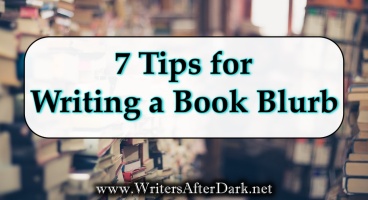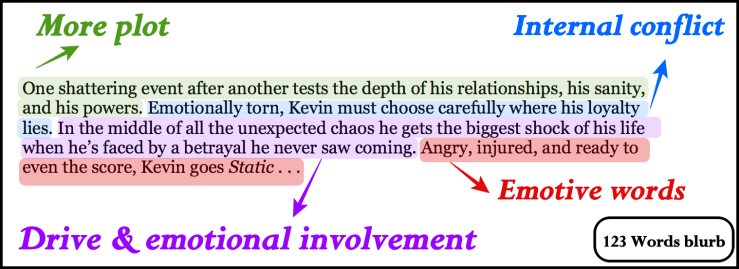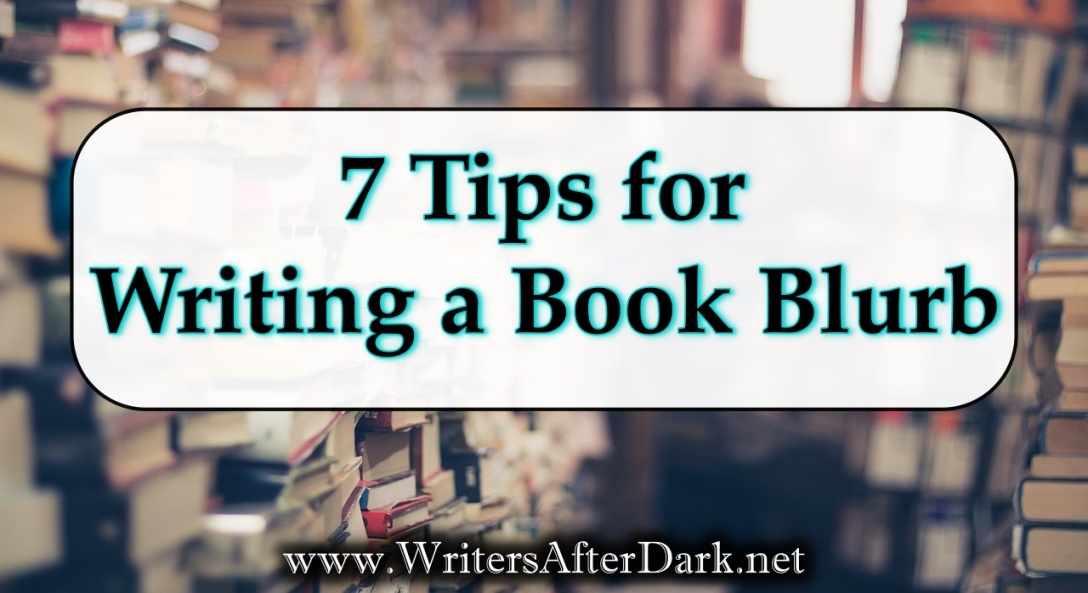
I’m here to help stop the madness. You know the one. The insanity that accompanies the “fun” of writing a book blurb. Attacking is more like it . . . I could stab it upside the head if it had one. But alas. Don’t let my bitterness get to you. In fact, use it to rise above me . . . with my own help, ironically. So let’s just get straight to it:
What on earth is a book blurb and why do you need one?
A book blurb is an important tool in convincing your readers to buy your book. Essentially, it’s a sales pitch. And you want it to be KILLER.
A reader will browse the shelves (or Kindle), and will find themselves intrigued by that amazing book cover of yours. Yay! You caught their attention. But you need more than that. You need to make a “sale” and that’s where your description blurb comes in. Not to be confused with a review blurb—we’re covering the back cover blurb, which is used to introduce your story to the reader. You know, that short summary on the back of your book we’re gonna use to pull that sucker in.
I’ll be honest. I’ve drowned myself in a whole bottle of wine because of that innocent-looking-150-words blurb in the past. I’m not proud of how difficult I found it, but I’m glad because—even though I’m no authority here—the challenges have taught me a lot. Such as: whatever you do, don’t get in your head on what you think you should share. Do these things instead:
1- First and foremost, keep the reader in mind. Your audience is what matters. Go ahead and browse similar genre blurbs and pay attention to what you find effective. It will help you figure out what your reader wants. Most importantly, help them relate to your main character and you’re golden!
2- Don’t make it into a synopsis. There’s a difference between a synopsis and a book blurb. The synopsis is a summary of the whole story and is usually intended for an editor/agent. It shows what happens throughout the whole story, including how it’s all resolved. A back cover blurb awakens the appetite in the reader to read the whole book without giving anything away.
3- Don’t make it too long. Most blurbs run three to four paragraphs long, but don’t go over 150 words. I know, I know . . . how mean to make you describe your novel—which is hundreds of pages long—in a few short paragraphs. But you can do it (and if you’re having a tough time, I suggest a bottle of wine). (Also, wait ’til you have to summarize your whole book in one sentence. #NotFun #Cheers)
4- Use emotive words to reach the reader. Words like “powerless,” “alienated,” “shocked,” or “heart-wrenching” helps with getting the potential reader feeling invested in your story. Or annoyed if you overuse them. So do it sparingly, and only to add a punch. I like it at the end . . . which is why I say:
5- Finish with a punch! Give the reader a reason to want to pick up the book. Personally, I’m not a fan of questions, but it is popular. “How will Kevin find the light when all is lost?” or something like that. Whatever your preference, just make it provocative and try to get the reader’s heart pumping.
6- Watch the tone. Is there tension, comedy, or action? Using the voice of the book to write the blurb helps with setting the tone for the reader. It depicts a hint of what’s to come.
7- Break down the paragraphs! I’ll use one of my blurbs as an example in this section. I’m going to break down STATIC (The Luminaries, Book Two). And here’s the blurb:
Kevin Pierce is a teleporter, a ladies’ man, and a loyal friend. Or so he thought.
As a genetically altered Luminary, he helps the government bring down some of the most dangerous criminals. Not very challenging if you have his special abilities. But when a group of rebel Luminaries attacks his Organization the fight for survival begins.
One shattering event after another tests the depth of his relationships, his sanity, and his powers. Emotionally torn, Kevin must choose carefully where his loyalty lies. In the middle of all the unexpected chaos he gets the biggest shock of his life when he’s faced by a betrayal he never saw coming. Angry, injured, and ready to even the score, Kevin goes Static . . .
First and second paragraphs– Introduce your heroine or hero along with a simple plot idea and a hint of his/her ARC.

Present the general conflict and tell us what the hero’s goals are. What’s at stake? If this is a fantasy or sci-fi genre, also introduce the setting.

Third and fourth paragraphs– Further set up the general plot and introduce secondary characters if necessary (such as the villain). Indicate the interior conflict. What’s our hero’s emotional involvement? Hint at what must be achieved and what drives him/her to it.

So there you have it. A recipe for a blurb that promises a good read. Do that and you’ll get one step closer to closing the deal!
If you have more tips, please comment and share them below! Thanks!
By
S. Katherine Anthony


Reblogged this on Lonely Power Poles and commented:
Gud advice – and the book advertising is subtle rather than in your face!
LikeLiked by 1 person
Thanks for sharing! 😀
LikeLiked by 1 person
Thanks for writing a great post!
LikeLiked by 1 person
Thanks for this post. I hate the idea of writing the blurb. It can feel like a bigger challenge than the book itself.
LikeLiked by 1 person
It really is a big challenge! It does get easier, but that depends on how much you let insecurity take over lol Thanks for stopping by! 😀
LikeLike
Great post! I haven’t even let myself think about the blurb stage yet, thanks for the tips!!
LikeLiked by 1 person
Ooh! Enjoy this kind-of-stress-free phase then lol
Thanks for reading it!!! ❤
LikeLike
Blurbs are fun little beasts to write, but beasts nonetheless. I’d add keeping searchable keywords in mind as well.
LikeLiked by 1 person
Awesome tip! I, personally, will have to work on that myself lol Those little beasts really get the best of me 😛
LikeLiked by 1 person
Really useful to see it broken down like that. Thank you!
LikeLiked by 1 person
I’m so glad you find it useful! Thank you so much for reading and commenting! ❤
LikeLiked by 1 person
[…] over at Writers After Dark (@WritersAfterDrk) has written an informative piece called “7 Tips for Writing a Book Blurb.” You can read the post yourself, but essentially Ms. Anthony sums up the book blurb as […]
LikeLike
Does it feel like I’m stalking you today? LOL! Good post! I bought an 82-page book on blurbs. You shared the same basic info in ONE blog post! You now officially own the Internet! Thanks!
LikeLiked by 2 people
LOL hands down, my favorite comment so far . . . I wonder why? 😛
You know, I probably read said book. I read several books on a particular topic before trying my best to break it down. Some are hit or miss, but hey, I’m just sharing my interpretation from what I learn. We’re all in this crazy writing world together after all! 😀
LikeLiked by 1 person
[…] 7 Tips for Writing a Book Blurb […]
LikeLike
Reblogged this on Words To Captivate ~ by John Fioravanti and commented:
Frustrated writing book blurbs? Join the club! S. Katherine Anthony gifts us with some solid advice and an illustrated example. Please, read on…
LikeLike
Reblogged this on When Angels Fly.
LikeLike
Love this! Than you!
LikeLike
I can’t say for sure whether they’re necessarily good, but writing blurbs for my books has always come naturally to me – and I believe I follow this formula to a degree. Its often on of the first things I write for my boom (once I have an idea of the plot) and then tweak it as I go.
LikeLiked by 1 person
It comes naturally to you? I wanna be you when I grow up LOL — I SO stress over blurbs! 😂
LikeLiked by 1 person
Firstly, omg those typos xD
But yeah, idk, i *think* im good at emulating blurbs
LikeLike
Reblogged this on Ace Parks and commented:
I’ve read multiple times that blurbs are things people struggle with. Here’s some tips and a useful formula!
LikeLiked by 1 person
Thanks so much for sharing the post! ❤
LikeLiked by 1 person
This is so useful! Will take these tips on board!
LikeLiked by 1 person
I’m so glad you found it helpful! ❤
LikeLiked by 1 person
[…] 7 Tips For Writing a Book Blurb […]
LikeLike